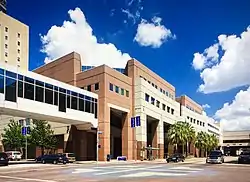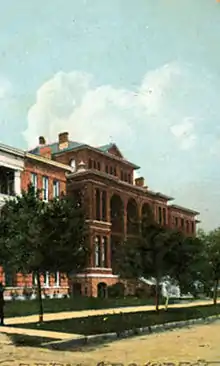St. Joseph Medical Center (Houston)
St. Joseph Medical Center (SJMC) is a general acute care hospital in Houston, Texas owned by Steward Health Care. Established in June 1887, SJMC is recognized as the first hospital in Houston. A new hospital was constructed in 1894, but was destroyed by fire soon thereafter. The hospital was rebuilt and it underwent major expansions in 1905 and 1938. The hospital was the largest in the city until the Texas Medical Center was established. The hospital has a capacity of 792 beds.[1] A second location was open in the Houston Heights from 2012 to 2019.
| St. Joseph Medical Center | |
|---|---|
| Steward Health Care | |
 St. Joseph Women's Medical Center (2014) | |
 SJMC Location within Downtown Houston | |
| Geography | |
| Location | 1401 St. Joseph Parkway, Houston, Texas, United States |
| Coordinates | 29°44′54″N 95°21′58″W |
| Organization | |
| Care system | For-profit |
| Type | General acute care hospital |
| Affiliated university | Steward Health Care |
| Services | |
| Emergency department | Downtown Campus Level III Trauma Center / Heights Campus Level IV Trauma Center |
| Beds | 792 |
| History | |
| Opened | 1887 |
| Links | |
| Website | St. Joseph Medical Center |
| Lists | Hospitals in Texas |
Early history

St. Joseph's Infirmary was founded in 1887 by a Catholic order known as the Sisters of Charity of the Incarnate Word. The original building was an old frame structure at the corner of Caroline Street and Franklin Street.[2] The year after it was established, the hospital entered into an agreement with the Harris County Commissioners Court to care for the city's indigent patients.[3] The hospital earned a great deal of community support due to the care it provided to victims of an 1891 smallpox outbreak.[2]
A new facility, larger and made of brick, opened in 1894.[2] The facility was built by architect Nicholas J. Clayton, who also built numerous historic houses and major commercial buildings in Galveston and Houston.[4] The hospital was destroyed a few months later by a fire that started at a nearby boarding house. The fire killed two of the sisters who belonged to the order.[5] All of the patients were kept safe during the fire.[2] A few months after the fire, a new building was completed after the order received monetary donations from Houstonians. The new hospital was located at the corner of Crawford Street and Pierce Street, which is now occupied by one of the hospital's buildings in Downtown Houston. At the time, the site was in a quiet residential area.[2]
A new three-story brick structure was constructed in 1905.[6] By 1919, St. Joseph was a 350-bed hospital that offered a range of medical and surgical services.[7] The Bishop Byrne Annex was dedicated in 1919.[8]
In 1920, an article in the Texas State Journal of Medicine mentioned that it had a strong nursing school and characterized the hospital as "an institution second to none in the south".[9] In 1921, the hospital was listed as one of 12 Texas hospitals with over 100 beds that received Approved Hospital status following a site visit by the American College of Surgeons.[10]
Expansion: 1930s and 1940s
In 1938, a new maternity building was constructed in a $750,000 expansion (equivalent to $15,592,199 in 2013).[7] The new construction was financially supported by the George W. Strake family, longtime donors to the hospital. A 1940 expansion added a new hospital wing and a new convent building.[11] At one time, the hospital was known as "Houston's birthplace" because of the number of babies who were born there.[12] After the 1947 Texas City disaster, the hospital received injured victims of the massive explosion. An account in the Annals of St. Joseph's Infirmary indicates that the hospital's emergency room treated more than 50 people injured in the disaster.[13] St. Joseph remained the largest hospital in Houston until the establishment of the Texas Medical Center.[7]
1950s and 1960s
In the 1950s and 1960s, a number of notable physicians practiced at St. Joseph. Mavis Kelsey, who later founded the multispecialty Kelsey-Seybold Clinic, was a member of the medical staff.[14] The hospital's plastic surgery chief, Dr. Thomas Cronin, met with representatives from Dow Corning in 1961 to discuss alternatives to sponge implants for breast augmentation. Dr. Cronin and his plastic surgery resident Frank Gerow are credited with developing silicone gel implants during those meetings with the company.[15] The Dow Corning Cronin Dacron breast implant was used in 88% of breast augmentation procedures by the early 1970s.[16]
Before the establishment of Texas Children's Hospital in 1954, St. Joseph had a clinical affiliation with the Department of Pediatrics at Baylor College of Medicine.[17] In 1950, St. Joseph pediatrician and Baylor professor Allan Penny Bloxsom introduced the Bloxsom air lock device for the delivery room resuscitation and oxygenation of distressed newborns. Bloxsom recognized that infants born by C-section more often required resuscitation. He theorized that uterine contractions (absent in many babies born by C-section) helped to prepare a fetus for the task of breathing. His tube-like device created fluctuations in air pressure that simulated contractions of the uterus. The Bloxsom air lock device was utilized by over 700 hospitals by late 1952.[18] Its use declined after a 1956 clinical trial showed that it did not improve outcomes over care in the standard incubator.[19]
Herman A. Barnett, the first black medical school graduate at the University of Texas Medical Branch and the first black appointee to the Texas State Board of Medical Examiners, completed an anesthesiology residency at St. Joseph in 1968 and joined the hospital's medical staff.[20]
Recent history
Between 1995 and 1998, St. Joseph's number of outpatient visits increased from 69,644 to 137,239. In 1998, the hospital completed a three-year, $50 million expansion project, including a new pavilion chiefly designed for outpatient care.[21] The hospital's parent organization became known as CHRISTUS Health in 1999 after the merger of the Sisters of Charity Healthcare System in Houston and the Incarnate Word Health System in San Antonio.
In the summer of 2005, CHRISTUS Health Gulf Coast announced that it was placing St. Joseph up for sale. The system said that it would endeavor to find a buyer that could continue to operate the hospital. Analysts, including one with Towers Perrin, questioned whether any hospital system would purchase the facility. They questioned whether the hospital could survive considering its large indigent patient population, the age of the facilities, the competition presented by Texas Medical Center hospitals and the cost of the real estate in downtown Houston.[12]
In 2006, CHRISTUS Health Gulf Coast sold St. Joseph to Hospital Partners of America (HPA), a for-profit system that partnered with physicians to purchase and revitalize struggling hospitals. HPA renamed the hospital to St. Joseph Medical Center.[22] Under HPA, physician investors held approximately 20% ownership of the hospital. In June 2008, HPA abruptly closed both locations of its other Houston hospital, River Oaks Medical Center.[23] When the system closed River Oaks, that hospital owed creditors between $100 million and $500 million. HPA executives said that St. Joseph remained financially healthy and that there was no direct relationship between River Oaks and St. Joseph. In early July, HPA announced that it was placing all of its hospitals on the market.[24]
In May 2011, Iasis Healthcare purchased the 79% of the hospital not owned by physician investors.[25] At the time of the sale, St. Joseph had an enterprise value of $165 million and it generated $245 million in annual revenue.[26] St. Joseph has been designated a Level III trauma center by the Texas Department of State Health Services.[27]
From 2012 to 2019, St. Joseph operated a second hospital location at 1917 Ashland Street in the Houston Heights. The facility was located on the grounds of the former Heights Hospital. Health services had been offered on the grounds for much of the last several decades, but hospital acute and emergency services had not been offered at the location for nearly 20 years until St. Joseph opened there. The location closed due to low patient demand.[28][29]
In August 2015, an unarmed patient experiencing a psychotic episode was shot by off-duty police officers providing security services at the hospital. The patient survived, but subsequent investigations uncovered patient rights violations and patient safety issues that jeopardized the hospital's funding from the Centers for Medicare & Medicaid Services (CMS). Later that year, CMS announced that it would no longer provide funding to the hospital.[30][31] However, in January 2016, SJMC and CMS reached an agreement allowing the hospital to remain funded while certain deficiencies were addressed.[30]
In November 2015, St. Joseph Medical Center opened two offsite cancer centers in affiliation with Integrated Oncology Network, LLC and its subsidiary Sightline Health, LLC (“ION”).[32] The St. Joseph Cancer Center - Med Center is located near the Texas Medical Center at 9150 S. Main and the West Houston location is in the Westchase District at 2610 W. Sam Houston Parkway South.
In October 2017, the hospital changed ownership when Iasis Healthcare was acquired by Steward Health Care.[33]
Notable births
- Jim Parsons known for his roll as Sheldon Cooper on The CBS Television Sitcom The Big Bang Theory was born there on March 24th 1973
Notable patients
- Lenwood Johnson (died May 2018[34])
References
- "IASIS Healthcare Signs Definitive Agreement to Purchase St. Joseph Medical Center". Information Technology Newsweekly. April 5, 2011. Archived from the original on September 24, 2015. Retrieved December 27, 2013.
- Culbertson, Margaret (Winter 2009). "Here and Gone" (PDF). Cite Magazine. Retrieved December 28, 2013.
- "Harris County Hospital District" (PDF). Harris County Archives. Retrieved December 28, 2013.
- Nesbitt, Robert, Fox, Stephen. "Clayton, Nicholas Joseph". Handbook of Texas Online. Texas State Historical Association. Retrieved December 27, 2013.
{{cite web}}: CS1 maint: multiple names: authors list (link) - "Legacy: Timeline". Sisters of Charity of the Incarnate Word. Retrieved December 27, 2013.
- Moore, James T. (2002). Acts of Faith: The Catholic Church in Texas, 1900–1950. Texas A&M University Press. p. 29. ISBN 1585441392.
- Monsanto, Daniel E. (2009). Houston. Arcadia Publishing. p. 51. ISBN 978-0738571225.
- "Bishop Byrne Dedicates St. Joseph Annex." Houston Chronicle. May 6, 1919. Published online on Monday, November 14, 2016 .
- "Miscellaneous: Something About Houston". Texas State Journal of Medicine. 15 (12): 438. April 1920. Retrieved December 28, 2013.
- "List of Approved Hospitals, Capacity of 100 or More Beds". Bulletin of the American College of Surgeons. 6 (1): 15. 1922. Retrieved December 28, 2013.
- Moore, James T. (2002). Acts of Faith: The Catholic Church in Texas, 1900–1950. Texas A&M University Press. p. 152. ISBN 1585441392.
- Ackerman, Todd (July 25, 2005). "Historic St. Joseph hospital facing uncertain fate". Houston Chronicle. Retrieved December 28, 2013.
- Wall, Barbra Mann. (June 2008). "Looking Back: Celebrating Nursing History". American Journal of Nursing. 108 (6): 26–29.
- Kelsey, Mavis (1999). Twentieth-Century Doctor: House Calls to Space Medicine. Texas A&M University Press. p. 194. ISBN 0890968667.
- Ott, Katherine, Serlin, David, Mihm, Stephen (eds.) (2002). Artificial Parts, Practical Lives: Modern Histories of Prosthetics. NYU Press. p. 228. ISBN 0814761976.
{{cite book}}:|first=has generic name (help)CS1 maint: multiple names: authors list (link) - Bondurant, Stuart, Ernster, Virginia, Herdman, Roger (2000). Safety of Silicone Breast Implants. National Academies Press. p. 69. ISBN 0309065321.
{{cite book}}: CS1 maint: multiple names: authors list (link) - "Department of Pediatrics: About Us". Baylor College of Medicine. Retrieved December 28, 2013.
- "Infant air lock is needed by Anson hospital". Anson Western Observer. October 16, 1952. Retrieved January 2, 2014.
- Kendig, James, Maples, Philip, Maisels, M. Jeffrey (December 1, 2001). "The Bloxsom Air Lock: A Historical Perspective". NeoReviews. 108 (6): e116. doi:10.1542/peds.108.6.e116. PMID 11731643. Retrieved December 27, 2013.
{{cite journal}}: CS1 maint: multiple names: authors list (link) - "Breaking the Color Barrier – the First Wave (1927–1954, Section 13)". To Bear Fruit For Our Race. University of Houston. Retrieved December 28, 2013.
- Sit-Duvall, Mary (September 25, 1998). "Houston area hospital to open new pavilion". Knight Ridder Tribune News Service. Archived from the original on September 24, 2015. Retrieved December 27, 2013.
- "St. Joseph ushers in new CEO, name". Houston Business Journal. August 24, 2006. Retrieved December 28, 2013.
- Cook, Lynn (June 23, 2008). "River Oaks Hospital closes its two facilities". Houston Chronicle. Retrieved December 27, 2013.
- Cook, Lynn, Patel, Purva (July 4, 2008). "Troubled owner puts St. Joseph Medical Center up for sale". Houston Chronicle. Retrieved December 27, 2013.
{{cite news}}: CS1 maint: multiple names: authors list (link) - Rodak, Sabrina (May 2, 2011). "IASIS Acquires 79% Ownership Interest in Houston's St. Joseph Medical Center". Becker's Hospital Review. Retrieved December 27, 2013.
- Lawley, Erin. "Iasis buying Houston hospital". NashvillePost.com. Retrieved December 27, 2013.
- "Texas Trauma Facilities". Texas Department of State Health Services. Retrieved December 28, 2013.
- "A New Era In The Life Of A Houston Landmark". St. Joseph Medical Center. Retrieved December 27, 2013.
- "St. Joseph Medical Center in The Heights: St. Joseph Medical Center | A Steward Family Hospital | Houston TX". www.sjmctx.org. Retrieved August 6, 2023.
- Hagerty, Michael (August 20, 2016). "One year after St. Joseph shooting: hospitals relying more on armed security". www.houstonpublicmedia.org. Retrieved August 6, 2023.
- "St. Joseph Medical Center losing Medicare, Medicaid funding". khou.com. November 17, 2015. Retrieved August 6, 2023.
- "Integrated Oncology Network and St. Joseph Medical Center Announce Affiliation in Houston, Texas". PRWeb. Retrieved 2018-07-23.
- "Steward Health Completes Acquisition of IASIS Healthcare - Utah Business". Archived from the original on 2017-10-18. Retrieved 2017-10-18.
- Snyder, Mike; John D. Harden (2018-05-16). "Lenwood Johnson, public housing activist, dies at 75". Houston Chronicle. Retrieved 2019-01-02.